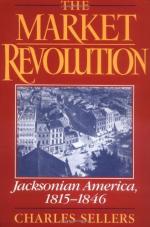
|
| Name: _________________________ | Period: ___________________ |
This test consists of 15 multiple choice questions and 5 short answer questions.
Multiple Choice Questions
1. What balance did the U.S. strike with the formation of a two-party system?
(a) Between capitalism and democracy.
(b) Between pro-slavery and abolition.
(c) Between hard currency and paper money.
(d) Between modern campaigning and grass-roots politicking.
2. What did South Carolina argue it could do?
(a) Negotiate treaties.
(b) Determine its own tariffs.
(c) Keep its own army.
(d) Nullify federal laws.
3. What did Biddle do in response to democratic pressure?
(a) Tighten money supply.
(b) Ease money supply.
(c) Raise interest rates.
(d) Lower tariffs.
4. What did Robert Owen advocate?
(a) Corporations.
(b) Tribunals.
(c) Communes.
(d) Unions.
5. What condition was the South in by the mid-1820s?
(a) Wilderness.
(b) Pre-capitalist.
(c) Industrial capitalist.
(d) Socialist.
6. What did Jackson think would bring financial stability back?
(a) Hard currency.
(b) Speculating on commodity prices.
(c) Derivatives trading.
(d) Paper money.
7. What group did northern capitalists exploit, in Sellers's account?
(a) Irish.
(b) Germans.
(c) Blacks.
(d) Hispanics.
8. What does capitalism result in, according to Sellers?
(a) The celebration of sex.
(b) The mechanicalization of sex.
(c) The sterilization of sex.
(d) Repression of sex.
9. How did Biddle ultimately make sure the Federal Bank would die, in Sellers's account?
(a) He neglected to consider the cost of the federal debt in debt maintenance.
(b) He played his policies just right.
(c) He mismanaged the monetary supply.
(d) He overplayed his hand.
10. How did internal trade change between 1820 and 1850?
(a) Remained the same.
(b) Tripled.
(c) Doubled.
(d) Declined by half.
11. How was the crisis that came from South Carolina's stance averted, according to Sellers?
(a) Slavery was allowed to move into western territories.
(b) The military was called in.
(c) The Constitution was amended.
(d) Tariffs were reduced.
12. What was Horace Mann's relationship with the public school system?
(a) He designed it.
(b) He argued for regulating it.
(c) He expanded it.
(d) He resisted it.
13. What does Sellers say was replacing agriculture in the U.S.?
(a) Commerce and transportation.
(b) Media and entertainment.
(c) Factory work.
(d) Slavery.
14. How did the desire of Northern manufacturers to restrict imports affect Southern planters?
(a) Raised the cost of cotton distribution.
(b) Raised the cost of labor for cotton processing.
(c) Lowered cotton production costs.
(d) Raised production cotton costs.
15. What were Unitarian elites trying to combine with the modern American capitalist economy?
(a) Slavery.
(b) Russian totalitarianism.
(c) European socialism.
(d) Romantic sentiment.
Short Answer Questions
1. What avenue did the Moderate Light use for pushing its agenda?
2. What was Jackson's belief about markets?
3. Who does Sellers say found New Light theology too radical?
4. On what grounds were people opposed to public schools?
5. How did Southerners see labor, according to Sellers?
|
This section contains 453 words (approx. 2 pages at 300 words per page) |

|




